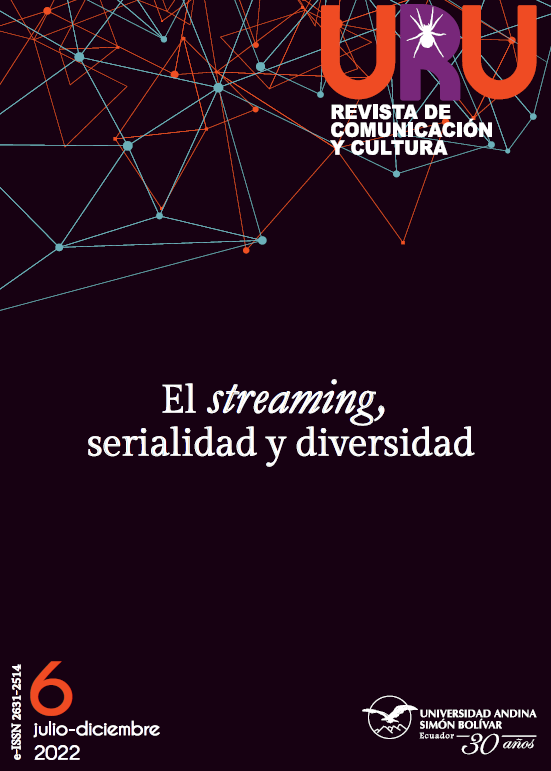On Media Convergence and Cultural Proximity: The Turkish Presence on Peruvian Screens
DOI:
https://doi.org/10.32719/26312514.2022.6.1Keywords:
Netflix, Turkish productions, television ecosystem, media convergence, cultural proximity, peruvian televisionAbstract
This text reflects on Turkish audiovisual products based on their offer and presence on Peruvian television in their different technologies -from broadcast to Video on Demand- from the theoretical approach of media ecology, and from the media convergence. It is proposed that the different television technologies -Netflix, other digital platforms, open signal and cable channels- are technologies that make up the television ecosystem that affects the reconfiguration of the television medium itself as a cultural system. In addition, it is identified that from Peru there is a cultural proximity with Turkish productions, which generates some displacements in the national television dynamics itself.
Downloads
References
Absatz, Cecilia. 2015. Las mil y una telenovelas: Cómo se cuentan las buenas historias en la ficción y en la vida. Buenos Aires: Planeta
Al Tamini, Jumana. 2012. “Challenge of the Turkish Soap Operas”. Gulf News. 1 de abril.
Cassano, Giuliana. 2018. “Telenovelas turcas en la televisión peruana”. Ponencia presentada en el XXXVI Congreso Internacional LASA, Barcelona, 23-26 de mayo.
Cassano, Giuliana. 2019. “Representaciones de género y melodrama televisivo en el Perú: Una mirada al siglo XXI”. Tesis doctoral, Pontificia Universidad Católica del Perú.
Cassano, Giuliana. 2021. “Digital Transformation: Turkish Melodramas on Peruvian television”. En Transnationalization of Turkish Television Series, editado por Özlen Arda, Pinar Aslan y Constanza Mujica, 113-25. Estambul: Istanbul University Press. DOI: https://doi.org/10.26650/B/SS18.2021.004.007
CPI. 2019. “Netflix y su crecimiento explosivo en Lima Metropolitana”. Reporte n.° 6. Compañía Peruana de Estudios de Mercados y Opinión Pública.
Detleff, James, Giuliana Cassano, Guillermo Vásquez, y Thalía Dancuart. 2022. Señal abierta: Una mirada a la televisión peruana del siglo XXI. Lima: Pontificia Universidad Católica del Perú.
El Comercio. 2015. “‘Fatmagül’ le ganó a ‘Las mil y una noches’ en el rating”. El Comercio. 5 de mayo.
El Comercio. 2020. “Netflix: ¿Qué vieron los peruanos durante este año atípico 2020 en la plataforma de streaming?”. El Comercio. 14 de diciembre.
Elizondo, Jesús. 2014. “Comprendiendo la historia desde la comunicación: Medios, medio e historia”. Contratexto 22: 53-71. DOI: https://doi.org/10.26439/contratexto2014.n022.88
Facultad de Comunicaciones. 2014. “Juan Ignacio Vicente, gerente de contenidos internacionales de Mega: ‘Las Mil y una Noches vuelve a las teleseries tradicionales clásicas’”. Facultad de Comunicaciones. 4 de septiembre.
Jenkins, Henry. 2008. Convergence culture: La cultura de la convergencia de los medios de comunicación. Barcelona: Paidós.
Julio, Pablo, Francisco Fernández, Constanza Mujica, Ingrid Bachman, y David Osorio. 2015. “Chile: La conquista turca de la pantalla”. En Obitel 2015: Relaciones de género en la ficción televisiva, coordinado por Guillermo Orozco y Maria Immacolata Vassallo, 159-94. Porto Alegre, BR: Sulina.
Lobato, Ramon. 2020. Netflix Nations: Geografia della distribuzione digitale. Roma: Minimum Fax. DOI: https://doi.org/10.18574/nyu/9781479882281.001.0001
Monge, Yolanda. 2020. Netflix suma casi 16 millones de nuevos usuarios durante la pandemia. El País. 21 de abril.
Mutlu, Dilek Kaya. 2010. “Between Tradition and Modernity: Ye?ilçam Melodrama, Its Stars, and Their Audiences”. Middle Eastern Studies 46 (3): 417-31. DOI: https://doi.org/10.1080/00263200902907169
Nas, Alparslan. 2018. Media Representations of the Cultural Other in Turkey. Estambul: Palgrave MacMillan. DOI: https://doi.org/10.1007/978-3-319-78346-8
Netflix. 2022. “¿Dónde está disponible Netflix?”. Netflix. Accedido 21 de abril. DOI: https://doi.org/10.2307/j.ctv2zrpd8j.12
PE CONCORTV. 2019. “Estudio cuantitativo sobre consumo televisivo y radial en adultos”. Consejo Consultivo de Radio y Televisión. Octubre.
Perú21. 2020. “Los peruanos y Netflix: Así reaccionan los fanáticos de las series”. Perú21. 28 de agosto.
PRODU. 2020. “Webinar PRODU: El comportamiento de las audiencias en pandemia. PRODU. 29 de julio.
—. 2021. “Kanal D Drama lanza SVOD en las Américas y España”. PRODU. 15 de septiembre.
Ramos, Carlos, Rosa Castillo, y Ana Oliva. 2016. “Los OTT TV como nuevos proveedores de contenidos audiovisuales y su impacto en la TV de paga”. Documento de trabajo. OSIPTEL.
Reyes de la Maza, Luis. 1999. Crónica de la telenovela: México sentimental. Ciudad de México: Clío.
Rivero, Ezequiel. 2019a. “La codicia de Netflix”. Página 12. 14 de febrero.
Rivero, Ezequiel. 2019b. “Viaje al fondo de Netflix”. Revista Fibra 24.
Scolari, Carlos. 2015. Ecología de los medios: Entornos, evoluciones e interpretaciones. Barcelona: Gedisa.
Señal News. 2020. “Kanal D Drama celebra su primer aniversario con audiencia millonaria”. Señal News. 28 de octubre.
Surfshark. 2022. “Which Countries Get the Best-Rated TV Shows & Films on Netflix?”. Surfshark. Accedido 27 de mayo.
Yesil, Bilge. 2015. “Transnationalization of the Turkish Dramas: Exploring the Convergence of Local and Global Market Imperatives”. Global Media and Communication 11 (1): 43-60. DOI: https://doi.org/10.1177/1742766515573274
Downloads
Published
How to Cite
Issue
Section
License

This work is licensed under a Creative Commons Attribution-NonCommercial-ShareAlike 4.0 International License.
ASSIGNMENT OF RIGHTS, DECLARATION OF CONFLICT OF INTEREST AND DISSEMINATION
The authors who publish in this journal accept the following conditions:
- Authors retain copyright and grant the journal the right of first publication, with the work registered under the Creative Commons Attribution-NonCommercial-ShareAlike 4.0 License, which allows sharing, adapting and attributing the work (see: Open Access Policies).
- Authors can make other independent and additional contractual agreements for the distribution of the article published in this journal (e.g., include it in an institutional repository or publish it in a book) as long as they expressly indicate that the article was published for the first time in Uru: Revista de Comunicación y Cultura. In the case of reproduction, a note similar to the following must be included: This text was originally published in the journal Uru: Revista de Comunicación y Cultura N ° -, year of publication.
- Authors are encouraged to publish their work on the Internet (e.g. on institutional or personal pages) in the final version published by Uru: Revista de Comunicaicón y Cultura as it may lead to a wider and faster dissemination of the published work.








